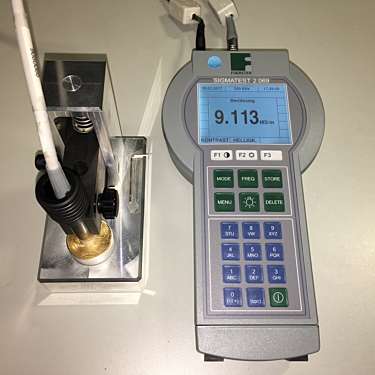X-Ray Fluorescence Testing

The handheld device shown above packs an amazing amount of science into a small volume, as can be seen from the display, which indicates the percentages of gold and copper detected in the surface layer of the material being examined.
Image credit: © Bundesbank / Roland Zils
The device shown here can generate a beam of X-rays which, when shone onto the test piece, causes the atoms in its surface layer to emit characteristic X-rays (through the process known as X-ray fluorescence, or XRF). By analysing the emitted X-rays, the device is able to calculate the percentages of the elements contained in the surface layer of the metal being examined.
XRF testers only indicate the composition of the outermost surface layer, so in order to examine the bulk composition of a test piece, it must be cut to allow the internal surface to be examined. Some years ago, retailers in India started to install this kind of equipment (known as caratmeters) to allow them to evaluate the fineness of scrap jewellery that customers wished to trade in. They did not prove popular with some members of the trade (simply because they highlighted the degree to which under-title jewellery was being sold in the Indian market).
XRF equipment is increasingly being used in the refining industry. Although it is not as accurate as other forms of analysis, the great advantage of XRF is that it provides an instantaneous assessment of the composition of the material being tested. Most refiners will use XRF for semi-quantitative determination of incoming materials, but several refiners use it for qualifying internal production of gold of fineness 995, a technique that became significantly more reliable after LBMA developed a solid sample reference material (known as AuRM3) for this type of fineness.
At the LBMA Assaying and Refining Conference in 2015, Dr Mike Hinds of the Royal Canadian Mint led a workshop on XRF testing, which explored many of the techniques and uses of this kind of equipment.
Detail
- Era
- Modern Period
- Related tags


